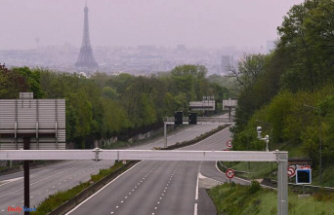Gone, it seems, are those days when the virus was everywhere. And if it wasn't the virus, it was the irrational idea that it could be killed. One confinement after another. Children whose conscience only knew that life of closures and limitations. Many ruined pockets. It was a loop of misfortunes under a strategy called Zero Covid turned into a political slogan that hit home deep at first, but after three years nobody believed it anymore.
The bubble of fears swelled until it exploded in the form of protests. The younger ones stood up. And for a regime that prioritizes social stability above all, that was a clear sign that plans had to be advanced to lift the yoke that was tied to the most populous country in the world.
China opened all its doors and turned its fatalistic narrative around. The game of fear is over and that an entire block of buildings would be quarantined because the neighbor from the ninth floor had passed through the door of a supermarket where a positive case had been reported.
But before going back to normal, the virus unsurprisingly had to hit a land that was virtually virgin to Covid infections. At the end of December and the beginning of January, the hospitals were saturated and the morgues full of corpses. There were queues waiting to cremate the dead. The streets of the big cities emptied. Almost everyone was passing the virus for the first time.
Meanwhile, in the West, they raised their hands to their heads and began to place restrictions on flights from China. Those who criticized the fact that the Asian giant maintained the eternal blockade also cried to heaven because Beijing suddenly collapsed that policy and wanted to learn to live with the virus once and for all, despite the great cost in human lives that this entailed. Close or open, China was always on target. After all, whoever had until then maintained the toughest restrictions in the world, was suffering from the deadly wave of infections that the rest had already overcome two years ago.
Now it can be said that total normality has returned to the big cities. And with it, the necessary internal consumption to revitalize an economy whose growth collapsed last year has skyrocketed again. This newspaper has witnessed this in the last month in three cities (Shanghai, Beijing and Wuhan), all of them with more than 10 million inhabitants. Cafes, restaurants and shopping centers to overflow. The streets, despite the cold, full of people walking or cycling.
Of course, almost everyone is still wearing a mask despite the fact that the explosion of infections has already passed. That's what the authorities say. But it is also what is seen at street level and at the doors of hospitals. The pressure for admissions to the ER has plummeted to practically normal levels. In funeral homes like those in Shanghai, there is still more movement than usual, but nothing to do with the collapse that was seen in January.
On Thursday, during a meeting of the leaders of the Asian giant that make up the Standing Committee of the Politburo, chaired by Xi Jinping, the Covid crisis was shelved. The top decision-making body of the Communist Party announced a "decisive victory" over the pandemic and called the "successful exit" from the Covid zero policy a "miracle".
Then, through the state chain CCTV, they gave some figures: 83,150 deaths from Covid since the restrictions began to be lifted in early December until February 9. A count that many researchers, both inside and outside of China, consider a gross underestimation of the real impact of deaths during the recent wave of infections. Even more so if one takes into account that around 80% of the more than 1,400 million inhabitants have been infected, according to the health authorities themselves. And this group includes many elderly people who had never been infected, who were not protected by vaccines and who live in rural areas where the health infrastructure is very deficient.
Is there any chance of ever knowing the real extent of deaths? Complicated, unless the Chinese authorities are fully transparent and, as they promised at the time, make a real estimate with the excess mortality rate since December, compared to years before the pandemic.
One problem noted by experts is that the published figure only includes infected people who died diagnosed with Covid in hospitals, excluding many who did so from underlying diseases or those who died at home.
This week, the New York Times published an article resulting from the work of four different academic teams to try to give a figure that is closer to reality. The conclusion they reached is that the wave of Covid in China may have left between a million and 1.5 million dead. Data on deaths similar to those reported by the United States throughout the pandemic and which coincide with the forecasts of studies published in scientific journals.
Chinese officials have spent the entire pandemic validating the three-year lockdown and slam reopening by saying their system is superior to that of a Washington-led fading West. It would be very difficult for the propaganda of Beijing to sustain and recognize that the Covid had finally left more deaths in China than in its great rival.
According to the criteria of The Trust Project












